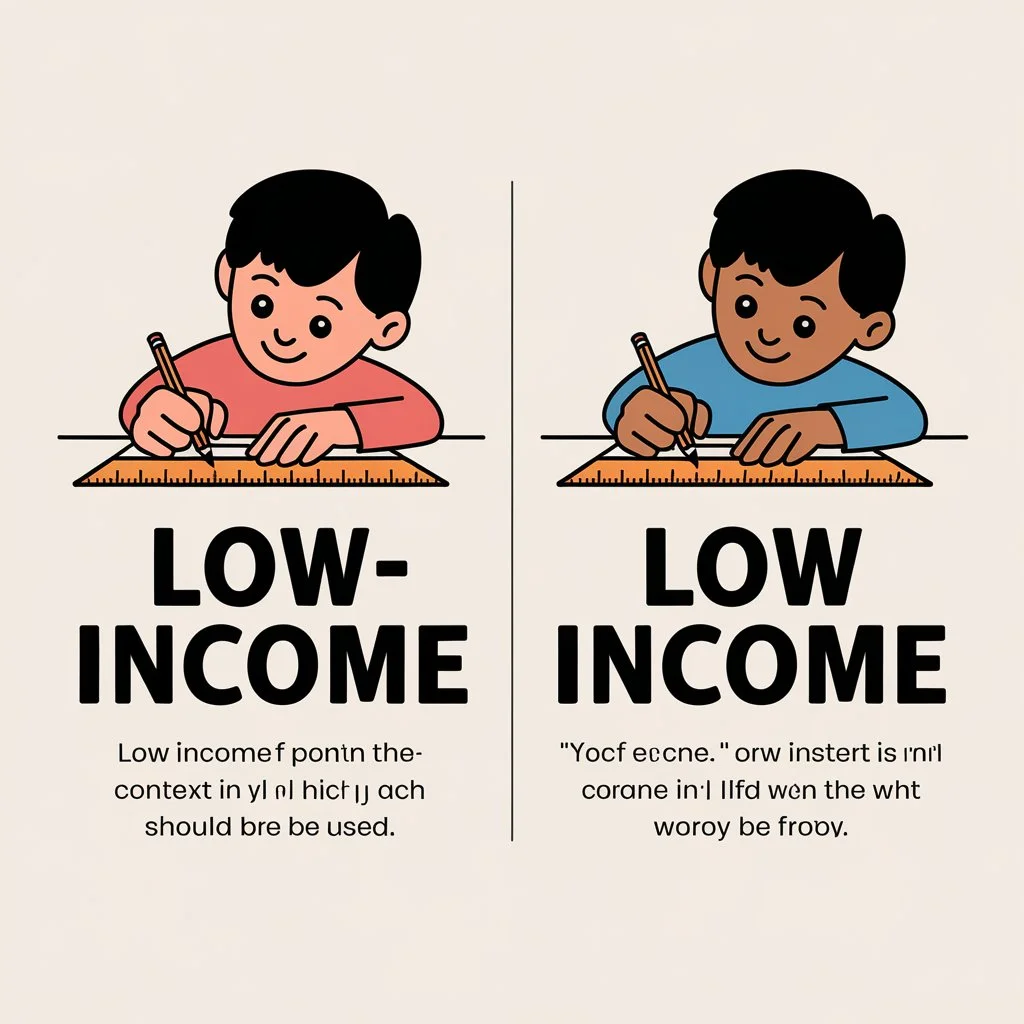When it comes to deciding whether “low income” should be hyphenated or not, the key lies in understanding the context. The hyphen is used when the phrase functions as an adjective to describe a noun or object. However, when the words are used as a noun on their own, they remain unhyphenated. Let’s explore these rules in detail. Understanding whether to hyphenate terms like low income or low-income can be confusing, but mastering this rule is important for clear and precise writing.
The presence of a hyphen changes the meaning and function of the phrase within a sentence. It’s crucial to know when to use “low-income” as an adjective versus when to use “low income” as a noun. By learning the correct usage, you can avoid errors that might confuse your readers. In this guide, we’ll clarify the rules and provide practical examples to help you apply them with confidence.
When To Use “Low Income” (Without a Hyphen)
When “low income” is used as a noun to refer to a state or category of being, it should not be hyphenated. Typically, you’ll find this usage at the end of a clause where the phrase describes a subject directly.
Examples:
- My family is low income.
- This neighborhood is low income.
- The country is considered low income.
- I can’t survive on a low income.
- I’ve always struggled with having a low income.
- My family is classified as low income.
- The report highlights the challenges faced by those living on a low income.
- Many people are struggling with low income in the current economy.
- Living on a low income can limit access to essential services.
- She has always had a low income due to her part-time job.
- The low income of many residents affects the local economy.
- He decided to advocate for policies that support low income individuals.
- Low income can lead to various social and health issues.
- The organization provides resources for families with a low income.
- They found it difficult to save money while on a low income.
- A low income often affects children’s educational opportunities.
- The survey focused on the experiences of low income households.
- He feels that a low income should not define a person’s worth.
- Access to affordable housing is crucial for those with a low income.
- The government offers assistance programs for people with a low income.
When To Use “Low-Income” (With a Hyphen)
The hyphen comes into play when “low-income” is used as an adjective. In this case, the phrase serves to modify a noun, giving readers more specific information about it.
Examples:
- We’re from a low-income household.
- Low-income areas are the worst affected.
- Low-income countries often face challenges providing for their citizens.
- We live in a low-income city.
- I can’t work in a low-income job.
- The low-income families in our community need more support.
- She works in a low-income school that serves underprivileged students.
- The low-income housing initiative aims to provide affordable options.
- Many low-income households struggle to meet basic needs.
- Low-income areas often lack access to quality healthcare services.
- He conducts research on low-income populations to understand their challenges.
- The government is implementing programs for low-income individuals.
- Low-income neighborhoods often face higher crime rates.
- They are launching a campaign to assist low-income seniors.
- The low-income community center offers free educational resources.
- Low-income students often qualify for financial aid.
- Her organization focuses on improving conditions for low-income workers.
- Low-income families may struggle with transportation costs.
- The project targets low-income children in need of after-school programs.
- Many low-income countries face significant developmental challenges.
AP Style and “Low-Income”
The AP stylebook emphasizes that hyphens function as “joiners” between two or more closely linked words. When used, these joined words work as adjectives to modify a noun or object in a sentence. Following this rule, “low-income” should always be hyphenated when it’s an adjective.
Capitalizing “Low-Income” in Titles
When it comes to capitalizing “low-income” in titles, the rules vary depending on the style guide you follow. There are three common title styles, and each treats hyphenated phrases differently:
- Style 1: Only the first word and proper nouns are capitalized. In this case, you would only capitalize “low” unless it appears at the beginning of the title.
- Example: Low-income families face challenges.
- Style 2: All words except for short prepositions, conjunctions, and articles are capitalized. You’d always capitalize “low,” but “income” would remain lowercase.
- Example: Low-Income Neighborhoods Need Support.
- Style 3: All words in the title are capitalized, regardless of length or significance. Both “low” and “income” would be capitalized in this case.
- Example: Low-Income Communities Are Affected.
Alternatives to “Low Income”
If you’re unsure about using “low income” or “low-income” and want to avoid any confusion with the hyphen, consider using synonyms. These alternatives carry the same meaning but can help you avoid the complexity of the hyphen rule.
Synonyms:
- Poor
- Destitute
- Impoverished
- Broke
- Underprivileged
Quiz: Low Income or Low-Income?
Let’s test your understanding of the hyphenation rules with a quiz. Choose between “low income” (no hyphen) and “low-income” (with a hyphen) in the following sentences.
- (A. low income / B. low-income) families live in this area.
- We live in a (A. low income / B. low-income) neighborhood.
- They say they’re (A. low income / B. low-income).
- This job is considered to be (A. low income / B. low-income).
- I hold a (A. low income / B. low-income) position.
Quiz Answers:
- B
- B
- A
- A
- B
FAQs
When do I use “low-income” with a hyphen?
Use “low-income” when it functions as an adjective describing a noun. This form provides specific information about the noun it modifies, making it clear that the subject belongs to a particular economic category. For example, in the phrase “low-income families,” the hyphen connects the words to indicate that these families share the characteristic of having low income. Other examples include “low-income housing” and “low-income workers.”
When should I use “low income” without a hyphen?
Use “low income” without a hyphen when it serves as a noun, usually appearing at the end of a clause. In this context, the phrase describes a state or condition rather than modifying another noun. For instance, in the sentence “My family is low income,” the phrase functions as a noun, indicating the economic status of the family. Other examples include “People living in low income often face challenges.”
Is it correct to say “a low income household”?
No, it should be “low-income household” because the phrase modifies the noun household, requiring a hyphen. The hyphen indicates that the adjective “low-income” functions together to describe the type of household being referred to. This clarification is essential for ensuring accurate communication, particularly in formal writing. Using the hyphen helps the reader quickly understand that the household’s defining characteristic is its low income.
What does the AP Stylebook say about hyphenating “low-income”?
The AP Stylebook recommends using hyphens when two words, like “low-income,” function as an adjective to modify a noun. This rule emphasizes clarity and prevents ambiguity in writing. Adhering to this guideline can improve the readability of your text, particularly in journalistic or formal contexts. Thus, terms such as “low-income communities” and “low-income programs” should be hyphenated to ensure proper understanding.
Should “income” be capitalized in “low-income” when used in titles?
It depends on the title style you follow. In most cases, you capitalize only “low” unless both words are capitalized in a particular title format. For instance, in a title following sentence case, it would be “Low-income Families in Need,” while in title case, it might be “Low-Income Families in Need.” Knowing the style guide you are using is important, as it dictates how to treat hyphenated phrases in titles consistently.
Are there alternatives to saying “low-income”?
Yes, you can use synonyms like poor, impoverished, underprivileged, or destitute to avoid confusion over hyphenation. These alternatives can provide variety in your writing while conveying similar meanings. Using different words can also help avoid redundancy and enhance the overall richness of your language. However, it’s essential to consider the context to ensure that the alternative accurately reflects the intended meaning.
Is there a difference between British and American usage of “low-income”?
No, both British and American English follow similar hyphenation rules when it comes to adjectives like low-income. This consistency means that writers can apply the same rules across different forms of English, simplifying the process of adhering to proper grammar. Therefore, whether writing for a British or American audience, the distinction between “low income” and “low-income” remains the same. This uniformity helps maintain clarity and understanding in international communications.
Can I use “low income” in formal writing without a hyphen?
Yes, as long as you’re using “low income” as a noun and not an adjective, it’s correct in formal writing without a hyphen. This flexibility allows you to convey the economic status effectively in various contexts, such as reports, articles, or essays. Using “low income” in its noun form helps to maintain a formal tone while accurately describing the financial situation. Just be mindful of the surrounding context to ensure clarity for your readers.
Conclusion
In summary, knowing when to hyphenate low-income is essential for effective communication. The rule is simple: use a hyphen when the phrase functions as an adjective and leave it out when used as a noun. By understanding this distinction, you can ensure your writing is both grammatically correct and easy to understand. Always consider the context and purpose of your sentence before deciding whether or not to include the hyphen. Whether you’re following AP style or another guide, the rules remain consistent. With this knowledge, you’ll avoid common errors and write with greater clarity.

It’s Elara Winters, your guide at “Grammer Grove.” I’ve dived into the intricacies of crafting the perfect English writing sections for your project, research paper, or thesis. With a wealth of experience in this field, I’m here to help you express gratitude and appreciation effectively. Join me on this journey, and let’s make your English writings shine!












